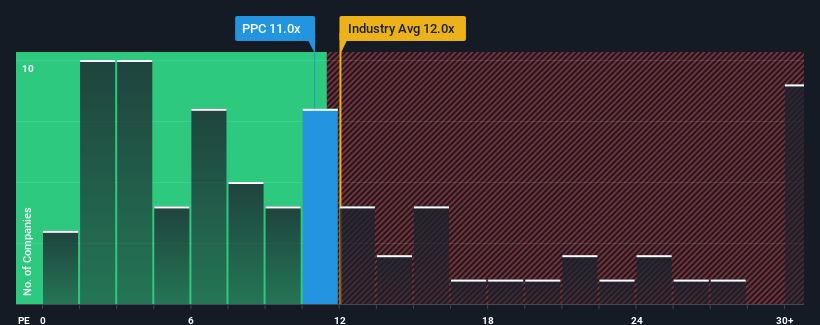- Greece
- /
- Electric Utilities
- /
- ATSE:PPC
It's A Story Of Risk Vs Reward With Public Power Corporation S.A. (ATH:PPC)

There wouldn't be many who think Public Power Corporation S.A.'s (ATH:PPC) price-to-earnings (or "P/E") ratio of 11x is worth a mention when the median P/E in Greece is similar at about 12x. While this might not raise any eyebrows, if the P/E ratio is not justified investors could be missing out on a potential opportunity or ignoring looming disappointment.
Public Power certainly has been doing a good job lately as it's been growing earnings more than most other companies. It might be that many expect the strong earnings performance to wane, which has kept the P/E from rising. If you like the company, you'd be hoping this isn't the case so that you could potentially pick up some stock while it's not quite in favour.
Check out our latest analysis for Public Power

How Is Public Power's Growth Trending?
Public Power's P/E ratio would be typical for a company that's only expected to deliver moderate growth, and importantly, perform in line with the market.
Taking a look back first, we see that the company grew earnings per share by an impressive 125% last year. The latest three year period has also seen an excellent 1,342% overall rise in EPS, aided by its short-term performance. Therefore, it's fair to say the earnings growth recently has been superb for the company.
Turning to the outlook, the next three years should generate growth of 12% per annum as estimated by the three analysts watching the company. Meanwhile, the rest of the market is forecast to only expand by 5.8% each year, which is noticeably less attractive.
With this information, we find it interesting that Public Power is trading at a fairly similar P/E to the market. Apparently some shareholders are skeptical of the forecasts and have been accepting lower selling prices.
What We Can Learn From Public Power's P/E?
Typically, we'd caution against reading too much into price-to-earnings ratios when settling on investment decisions, though it can reveal plenty about what other market participants think about the company.
Our examination of Public Power's analyst forecasts revealed that its superior earnings outlook isn't contributing to its P/E as much as we would have predicted. When we see a strong earnings outlook with faster-than-market growth, we assume potential risks are what might be placing pressure on the P/E ratio. At least the risk of a price drop looks to be subdued, but investors seem to think future earnings could see some volatility.
It is also worth noting that we have found 2 warning signs for Public Power that you need to take into consideration.
You might be able to find a better investment than Public Power. If you want a selection of possible candidates, check out this free list of interesting companies that trade on a low P/E (but have proven they can grow earnings).
New: Manage All Your Stock Portfolios in One Place
We've created the ultimate portfolio companion for stock investors, and it's free.
• Connect an unlimited number of Portfolios and see your total in one currency
• Be alerted to new Warning Signs or Risks via email or mobile
• Track the Fair Value of your stocks
Have feedback on this article? Concerned about the content? Get in touch with us directly. Alternatively, email editorial-team (at) simplywallst.com.
This article by Simply Wall St is general in nature. We provide commentary based on historical data and analyst forecasts only using an unbiased methodology and our articles are not intended to be financial advice. It does not constitute a recommendation to buy or sell any stock, and does not take account of your objectives, or your financial situation. We aim to bring you long-term focused analysis driven by fundamental data. Note that our analysis may not factor in the latest price-sensitive company announcements or qualitative material. Simply Wall St has no position in any stocks mentioned.
About ATSE:PPC
Public Power
Generates, transmits, and distributes electricity in Greece, Romania, Bulgaria, and North Macedonia.
Slight with moderate growth potential.
Similar Companies
Market Insights
Community Narratives




